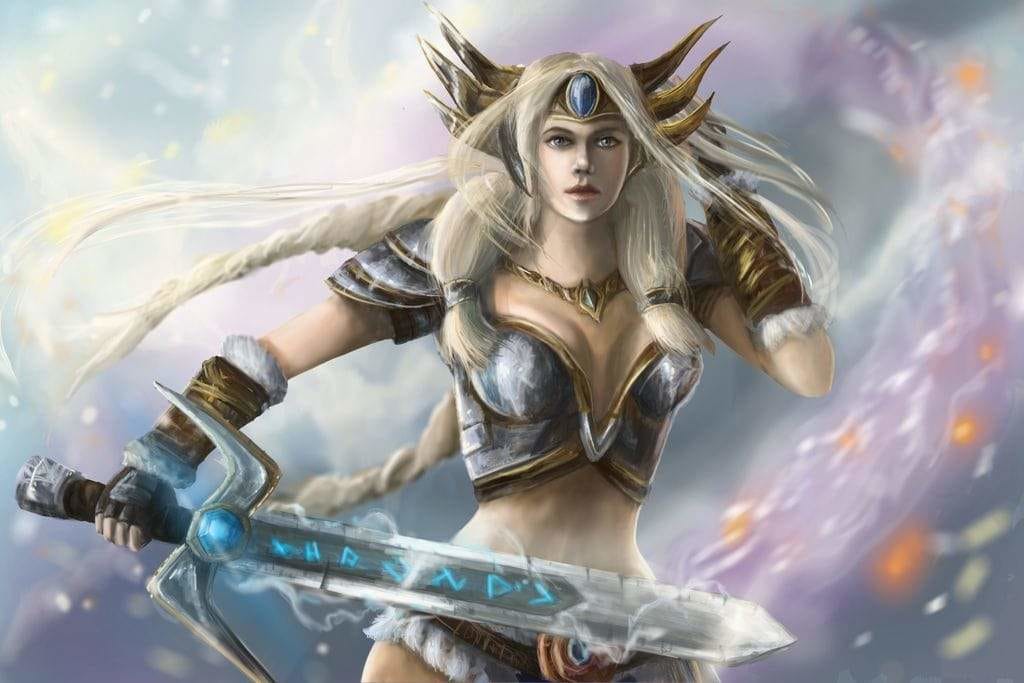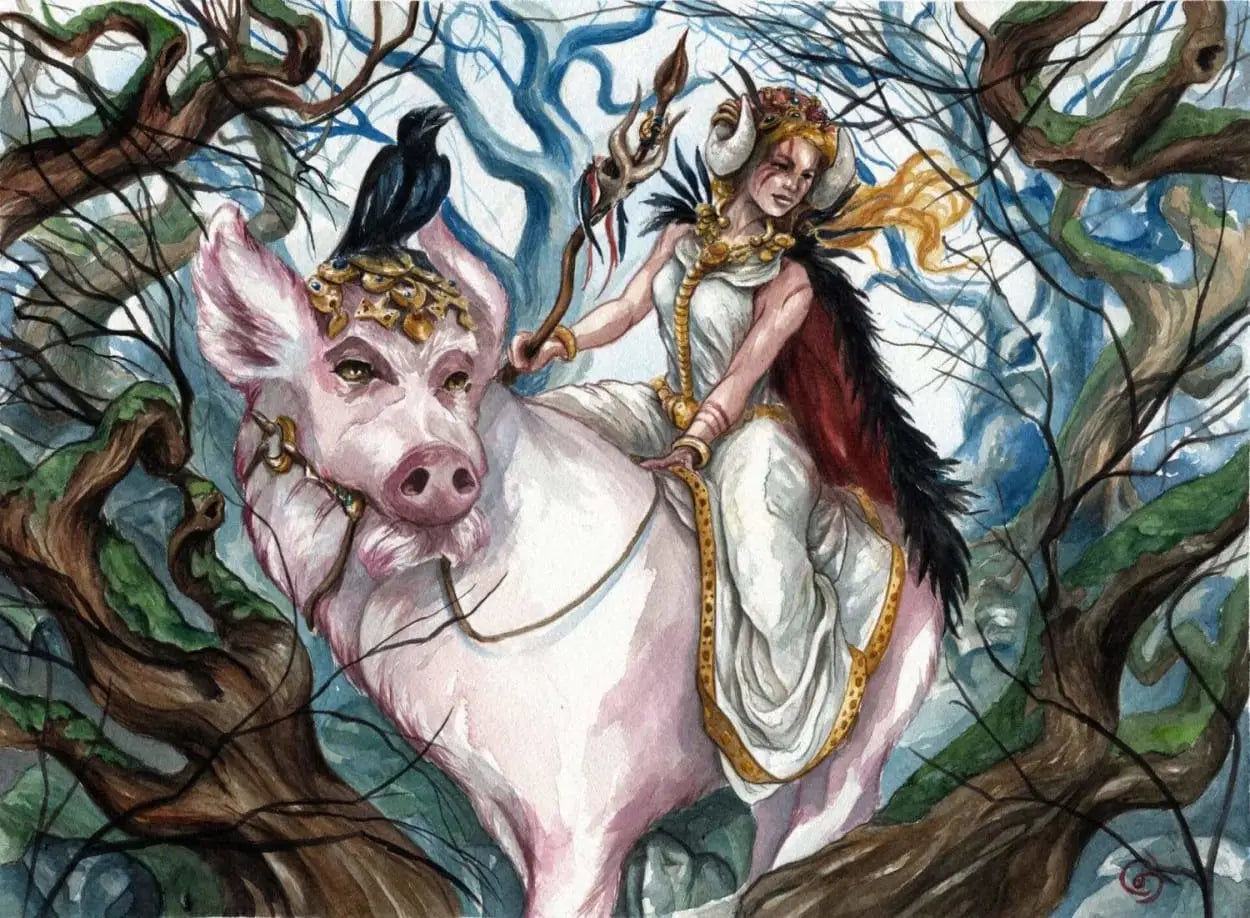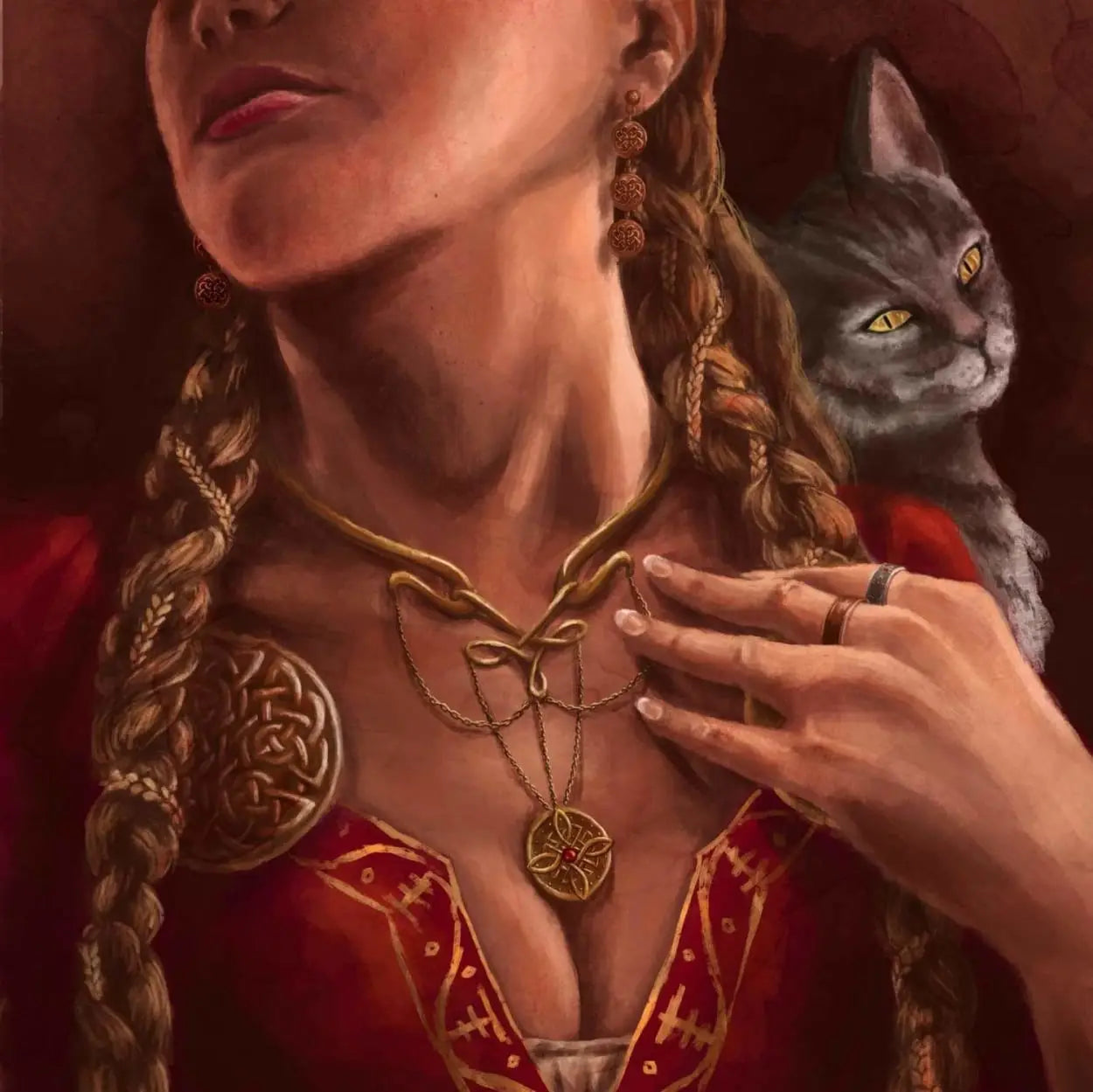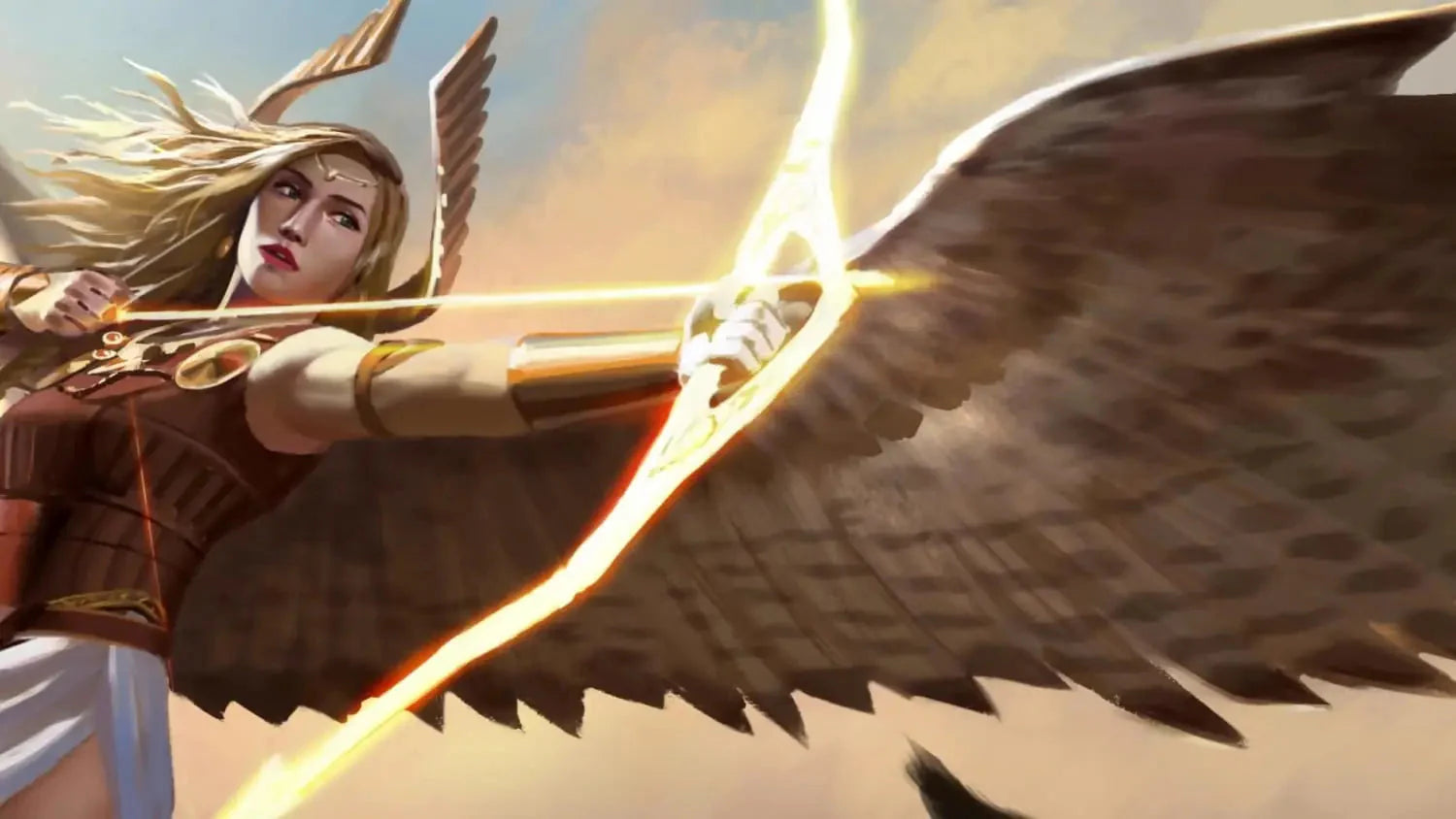Freya Norse Goddess. It seems like every mythology has a goddess of love and beauty, but the Norse goddess Freya was so much more than that, keep reading to find out why!
Associated with love, sex, lust, beauty, sorcery, fertility, gold, war and death, Freya was clearly among one of the most potent Norse deities.
This accounts for why there is evidence that the goddess has been continually venerated in some parts of Scandinavia until the modern day.
But who was Freya, the Norse goddess that stole the hearts of gods, dwarves and giants? See a great selection of our Viking inspired earrings.
Origins
In old Norse the name Freya simply means ‘lady’, and the term was also used as an honorific among Norse women. It is likely that she took the epithet at some point, and it came to replace her personal name, that has been lost in time.

According to Norse mythology, Freya Norse Goddess lived alongside the Aesir gods and goddesses and appears among them in their stories, she was not in fact an Aesir goddess, but rather one of the Vanir gods.
See our Great range of premium Viking bracelets and arm rings, perfect to show off your inner warrior.
This was a second race of gods in Norse mythology that conflicted with the Aesir because of their different lifestyle choices. For example, the Aesir did not approve of the Vanir practice of incest. These differences led to a war between the two races.

It was at the end of this war that Freya Norse Goddess, twin brother Freyr and their father Njord, were sent to Asgard as hostages. They quickly became part of the Aesir community.
Freya and Freyr were themselves children of incest, being the children of Njord, a god of the sea, and his twin sister Nerthus, a goddess of the earth. Before arriving in Asgard it seems that Freya and Freyr were also married, but the Aesir annulled the marriage as unlawful.

The Vannor goddess was instead married to Odr, a god about whom almost nothing is known, except that he often wandered and left Freya alone. According to Norse mythology, Freya would often wander the world in search of her husband, disguising herself by using a variety of names including Gefn, Horn, Mardoll, Valfreya and Vanadis.
Freya’s marriage does not seem to have stopped Freya continuing her relationship with her brother, and other men. However, she seems only to have had children with Odr, two goddesses, Hnoss and Gersemi, both of which rivalled their mother in terms of beauty.
Beauty
It is clear that Freya was the most beautiful of the Norse goddesses, and probably the most beautiful being in the Norse cosmos. While Freya is described as embracing this and celebrating it, her beauty was also the source of several problems for the Norse gods.

In one of the foundation stories in Norse mythology about Asgard itself, an unnamed builder offers to build the fortified walls around Asgard in exchange for the hand of Freya in marriage, the sun and the moon.
The gods try to get the wall without having to pay for it by demanding that the builder complete the wall in a single season and without the help of a single man. Nevertheless, the builder almost manages to complete the work thanks to the assistance of his mighty stallion Svadilfari.
Fearing that they will have to give the builder the goddess’ hand in marriage, the Norse gods enlist Loki to foil the builder. When he fails to complete the wall, Thor then killed the builder.
In a similar story from Norse mythology, the giant king Thrym steals , and the gods discuss how they will be able to infiltrate the hall of the giant to retrieve the hammer.
Thrym’s only weakness seems to be his passion for the goddess Freya, and the only way to enter the hall to send Freya there as his bride. Freya refuses to go, saying that she will be seen as promiscuous indeed if she agrees to go, even as a ruse.
In the end Thor must disguise himself in the guise of the goddess to infiltrate the hall, retrieve his hammer, and kill the giant king and his followers.
Sexuality
Despite her refusal to participate in the ruse against Thrym, Freya does not appear to have had a problem with using her beauty and sexuality to get what she wanted.

For example, she developed a deep desire for the necklace Brisingamen, the most beautiful piece of jewellery recorded in Norse mythology, made by four dwarven brothers.
The only payment for the necklace that the dwarves would accept was a night each with the goddess. It seems that Freya accepted willingly, probably thinking that sharing her ultimate art as the goddess of sexuality was a fair payment for this ultimate piece of art created by the dwarves.
War and Death
Freya Norse Goddess was also a goddess of both war and death, as according to Norse mythology, Freya collected half of the souls of fallen warriors on the battlefield to live in her home in Folkvangr. Odin collected the other half to live in Valhalla, a great hall in Asgard, where the souls would dwell until they were called on to fight again during Ragnarok, the end of the world.

However, unexpectedly, Freya appears to have had first choice of the fallen warriors, suggesting that the goddess had a great power in this realm than Odin, or that this was a favour that Odin bestowed on her for some unknown reason.
Whether these warriors would also be called upon to fight during Ragnarok is unclear, as is Freya’s role in the end of days. Her demise is not mentioned in the Ragnarok prophecy. This has led some to suggest that she survives to help rebuild the world, but this is purely speculation.
Attributes
Many attributes were associated with the goddess Freya, all of which reveal different elements of her personality and purpose as a goddess.
Freya has a falcon-feathered cloak that would allow her to fly in the form of a falcon. According to the stories of Norse mythology Freya lent this cloak to Loki on a number of occasions to help him undo some of the mischief that he inflicted on the Norse gods. This cloak also associates Freya with shapeshifting, and therefore links to her as a goddess of magic and sorcery.
Freya was also explicitly linked with Seidr magic, a kind of magic that involves discerning the course of fate and working within its structure to bring about change by weaving in new events. This was a very feminine type of magic that was associated with the Vanir gods, but Odin is also known to have practiced Seidr.
Like many of the Norse gods, Freya rode in a chariot, but her chariot was drawn by two cats, that were either black or grey, named Bygul and Trjegul. She was also known to ride a wild boar, and boars were associated with the Vanir gods. The boar that she rode, named Hildisvini, may have been her human lover Ottar in disguise. The goddess first turned him into a boar so that they would work together to uncover the secret of his giant ancestry so that he could claim his inheritance.
Freya was also associated with gold through her tears, which were said to turn into gold when they came in contact with land, and amber when they came into contact with water. Thus, the goddess of beauty was associated with creating some of the most beautiful substances known among the Vikings.
Freya Norse Goddess and Odr as Odin and Frigg
Some historians have suggested that Freya was in fact the goddess Frigg, and that her husband Odr was Odin, who is known to have often wandered the world in his quest for wisdom. This would explain the many parallels between Freya and Odin.
They were both linked with war and took fallen warriors to live in their halls, and they both practiced Seidr Magic.
This may also explain why so little is known about Frigg, despite being the most important of the Norse goddesses, as her mythology was largely given to Freya. This may also explain the suggestion that Frigg knows everyone’s destiny, as this would be a sort of Seidr magic.
Exploring the Enigmatic Freya: Unveiling the Allure of the Norse Goddess
In the realm of Norse mythology, amidst the tapestry of gods and goddesses, stands a figure of extraordinary power, grace, and allure - Freya. With her ethereal beauty, formidable prowess, and captivating stories, Freya takes centre stage as a symbol of love, war, fertility, and magic.
Join us as we delve into the captivating tale of Freya, the Norse goddess who holds the key to understanding the intricacies of a bygone era.
Table of Contents
- Introduction
- The Origins of Freya: A Divine Lineage
- The Goddess of Love and Beauty
- 3.1 The Enchanting Charms of Freya
- 3.2 Love Stories and Legends
- Freya: Warrior and Leader
- 4.1 Valkyries and Battlefields
- 4.2 The Brisingamen Necklace
- Fertility and Prosperity
- 5.1 Connection to Nature and Fertility Rituals
- 5.2 Celebrations of Life and Growth
- Mistress of Magic and Seidr
- 6.1 Seidr: The Ancient Norse Magic
- 6.2 Freya's Mastery of Seidr
- Iconography and Symbols
- 7.1 Cats and Falcons: Freya's Animal Companions
- 7.2 The Wheel of Freya: A Symbol of Destiny
- Mythology and Folklore
- 8.1 The Theft of Thor's Hammer: A Bold Endeavor
- 8.2 Freya's Unwavering Sacrifice
- Legacy and Influence
- 9.1 Freya in Modern Culture
- 9.2 The Link to Friday: Freya's Day
- Conclusion
Introduction
In the pantheon of Norse deities, Freya emerges as a multifaceted goddess, embodying an array of attributes that mirror the complexity of human experience. Known as "Freyja" in Old Norse, she was revered by the ancient Scandinavian people and continues to captivate our imaginations to this day.
The Origins of Freya: A Divine Lineage
Freya was born to the sea giant Skadi and the trickster god Loki. Her beauty was said to rival that of the most enchanting beings in the cosmos, capturing the hearts of gods and mortals alike.
The Goddess of Love and Beauty
As the goddess of love and beauty, Freya's influence extended over matters of desire, attraction, and devotion. Her tears were believed to transform into amber upon touching the earth, a symbol of her enduring sorrow and empathy.
The Enchanting Charms of Freya
With her alluring presence, Freya possessed an innate ability to captivate those around her. Her radiant beauty and aura of sensuality left a lasting impression on anyone fortunate enough to encounter her.
Love Stories and Legends
Numerous myths revolve around Freya's romantic escapades, often intertwining with the lives of other gods. Her pursuit of happiness led her on quests that showcased her courage and determination in the face of adversity.
Freya: Warrior and Leader
Contradictory to her gentle aspects, Freya was also revered as a warrior goddess, much like her male counterparts. She rode into battles alongside the Valkyries, deciding the fate of fallen warriors.
Valkyries and Battlefields
Freya's role in the realm of warfare was pivotal. As the leader of the Valkyries, she handpicked brave souls from the battlefield to join the ranks of fallen heroes in Valhalla.
The Brisingamen Necklace
One of the most renowned tales associated with Freya involves her possession of the Brisingamen necklace, a symbol of her sovereignty and sensuality. Its significance reverberates through the mythological narratives of the Norse.
Fertility and Prosperity
Freya's connection to fertility and prosperity was deeply ingrained in the lives of the Norse people. She was believed to bless marriages, aid in childbirth, and ensure bountiful harvests.
Connection to Nature and Fertility Rituals
Freya's connection to nature was instrumental in ensuring the cycles of life and growth. Her presence was invoked during fertility rituals, where offerings were made to secure a fruitful harvest.
Celebrations of Life and Growth
Festivals dedicated to Freya were celebrated with fervour, embodying the spirit of life and growth. These occasions were marked by feasting, merriment, and reverence for the goddess who bestowed such blessings.
Mistress of Magic and Seidr
Beyond her roles in love, war, and fertility, Freya held the title of a powerful sorceress skilled in seidr - an ancient form of Norse magic.
Seidr: The Ancient Norse Magic
Seidr encompassed divination, prophecy, and spellcasting. Practised by seidr-workers, this form of magic allowed access to hidden knowledge and manipulation of fate.
Freya's Mastery of Seidr
Freya's expertise in seidr was unparalleled. She ventured into the realm of dreams and visions, wielding her magic to shape destinies and uncover secrets that eluded ordinary perception.
Iconography and Symbols
Freya's iconography often featured powerful symbols that carried significant meanings in Norse mythology.
Cats and Falcons: Freya's Animal Companions
Two creatures closely associated with Freya were the falcon and the cat. These animals represented her dual nature - the falcon symbolising her connection to the heavens, and the cat signifying her earthy sensuality.
The Wheel of Freya: A Symbol of Destiny
The Wheel of Freya, a representation of the cycles of life, death, and rebirth, embodied the goddess's role as a guide through the twists and turns of existence.
Mythology and Folklore
Freya's stories intertwine with those of other gods, weaving a rich tapestry of myths that offer insights into the complexities of Norse culture.
The Theft of Thor's Hammer: A Bold Endeavour
One remarkable tale features Freya's cunning and bravery as she participates in the audacious plot to retrieve Thor's stolen hammer, Mjolnir.
Freya's Unwavering Sacrifice
In another poignant story, Freya's devotion shines through as she sacrifices her dignity to secure the release of her husband, Od, from the clutches of a malevolent giant.
Legacy and Influence
Freya's legacy transcends the bounds of mythology, leaving an indelible mark on modern culture and language.
Freya in Modern Culture
Her influence can be seen in various aspects of contemporary society, from literature and art to popular culture, where she continues to inspire characters and narratives.
The Link to Friday: Freya's Day
The name of the day "Friday" is derived from Freya's name, further highlighting her lasting impact on linguistic and cultural norms.
Conclusion
The enigmatic Freya, with her intricate blend of love, war, fertility, and magic, remains a symbol of the complexities of human existence. Her stories invite us to explore the layers of Norse mythology and ponder the timeless themes that resonate with us all.
FAQs
- Was Freya a popular goddess in Norse mythology?
- Absolutely, Freya held a significant place in Norse mythology, often revered for her diverse attributes.
- What is the significance of Freya's necklace, Brisingamen?
- The Brisingamen necklace symbolised both Freya's beauty and her authority, making it a cherished emblem in her stories.
- Did Freya have any enemies among the gods?
- While Freya had her share of conflicts, her interactions with other gods were more often marked by alliances rather than enmity.
- How did Freya's association with magic impact her role in Norse mythology?
- Freya's mastery of seidr magic added a layer of complexity to her character, emphasising her connection to the mystical and hidden realms.
- Why is Friday named after Freya?
- In many languages, the name for Friday is derived from the name of Freya, honouring her enduring legacy.
Read more great blogs at odinscave.com about Freya Norse Goddess.


Share:
Balder | The Shining One
Njord God | Norse God Of The Sea |The Ruler of the Sea